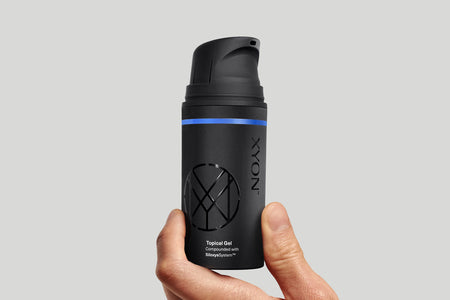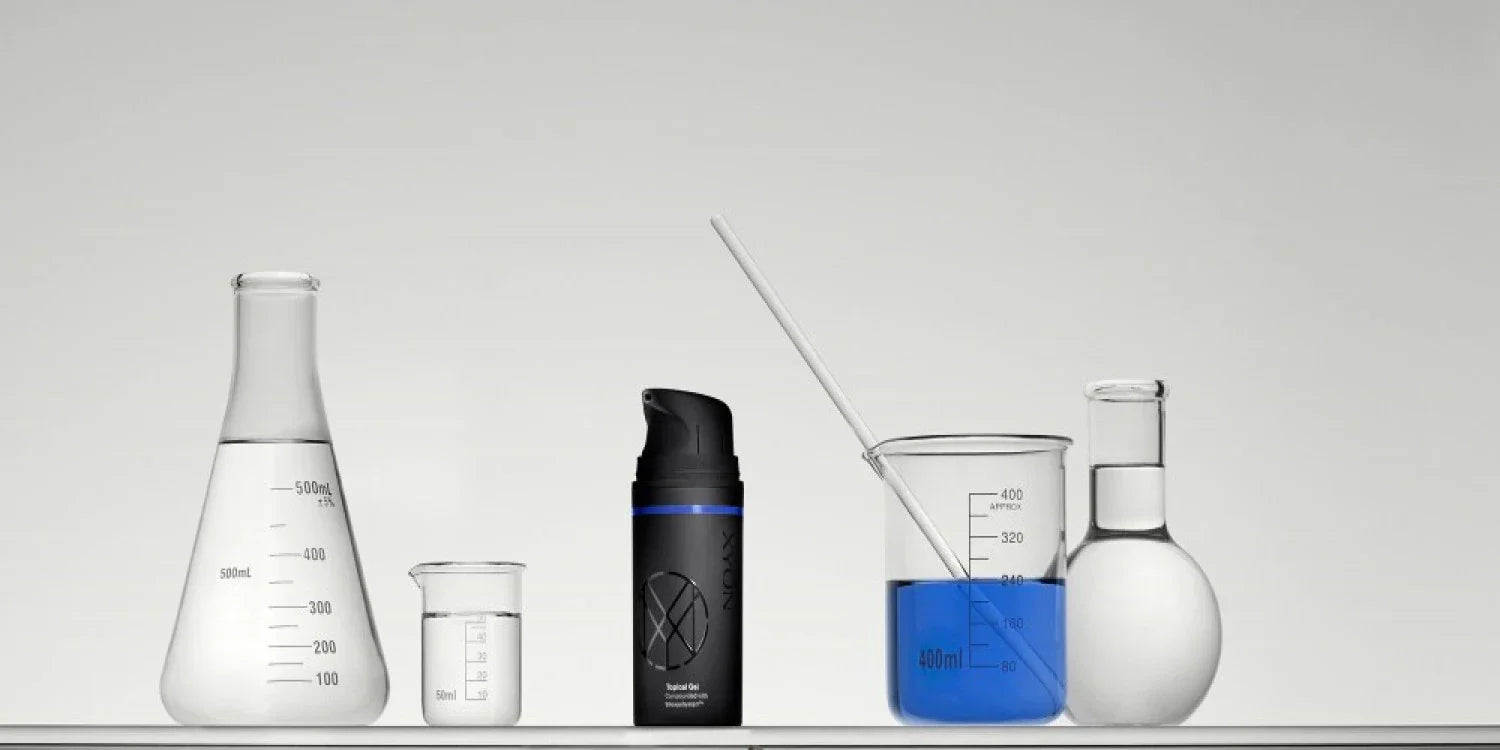Finasteride belongs to the class of drugs known as 5-alpha reductase inhibitors, whose role is to prevent testosterone from being converted into DHT. In doing so, they can help to lower the DHT levels at the scalp and minimize hair follicle shrinkage, which is the primary mechanism behind male pattern balding.
The hair loss treatment market is evolving every day and this means that new forms of finasteride are constantly being developed and made available for hair loss sufferers. Whilst this is great news for your receding hairline, it can be overwhelming when trying to figure out which finasteride dosage to go for.
We’re going to answer all your burning questions about finasteride to give you a better idea of which treatment might be the right fit for you.


Our topical finasteride is a safer way to block the DHT that causes hair loss
Interested in topical finasteride or just stopping hair loss? Our free online consultations are available so you know what product is right for you
What is the recommended finasteride dosage for hair loss?
1mg of oral finasteride daily is the FDA and Health Canada approved dosage for male pattern balding. But does this mean it’s the optimal finasteride dose? The answer isn’t entirely clear cut. Because hair loss is often multi-factorial, the best approach to treatment will vary from person-to-person. So, let’s get into the finer details:
Is 1mg of finasteride enough for hair loss?
Since finasteride is also sold at a 5mg dose for treating benign prostatic hyperplasia (BPH), many people wonder why they can’t take more than 1mg for hair loss. The answer is fairly simple: a higher dose doesn’t necessarily equate to better hair growth results.
The names Propecia® and Proscar® are thrown around a lot because they’re both branded forms of finasteride, but they serve completely different purposes. Let’s clarify the difference:
Propecia® is a 1mg finasteride tablet sold for male pattern hair loss, whilst Proscar® is a 5mg finasteride tablet used to treat BPH.
Since its approval as an oral treatment for hair loss in 1997, countless studies have proven oral finasteride to be an effective treatment for hair loss at 1mg. For example, in 2002 researchers observed the hair growth of men treated with oral finasteride over 5 years and compared their results to a group who received a placebo treatment. They found that 90% of the men treated with finasteride sustained visible improvement in scalp coverage or had no further hair loss over the course of the 5 years (Shapiro & Kaufman, 2003). Because of this and countless other similar findings, it was concluded that 1mg finasteride was a high enough dose for treating hair loss. It’s important to recognize that the right balance between safety and efficacy needs to be achieved when taking any medication.
Do I need to 1mg of finasteride daily for hair growth?
For your treatment to be most effective, finasteride usually needs to be taken consistently every day. Unfortunately, hair loss can’t be reversed overnight, so it’s important to be patient when starting your treatment. In most cases, it will take around 3 to 4 months to begin seeing results. This can be discouraging initially, sometimes causing people to stop taking the medication altogether, but consistency can pay off.
Every hair on your scalp is always in one of 3 main stages of the hair growth cycle and much of the hair growth that goes on happens beneath the surface of your scalp. So, while you’re taking finasteride, it is likely to be first having an effect on your hair follicle beneath the visible layer. This means that it can take some time for you to see noticeable results, but remembering to take your medication every day and sticking with it will maximize your chances of hair growth.
If you’ve been taking finasteride for a while and you’re worried that it isn’t working for you, you may want to speak to your doctor. There may be other forms of finasteride or different medications altogether that you can try. Keep reading to learn more about the other finasteride options that may be available.
Will I have more side effects if I take a higher dose of finasteride?
Higher doses of oral finasteride can be associated with more side effects, due to the impact on DHT levels body wide. This is evidenced in the higher reports of side effects associated with Proscar® (for BPH treatment), compared to Propecia® (for hair loss). According to the individual drug monographs, 8-19% of those taking Proscar ® develop erectile dysfunction, whilst only 1% of those taking Propecia® will develop this side effect. We can see based on the data that the risk of side effects correlates with the amount of medication that enters the body.
When it comes to topical finasteride, it’s not quite as simple. Since topical finasteride isn’t FDA approved, the amount of medication that’s incorporated into a topical format can vary significantly depending on where you buy it from. But a higher concentration of finasteride doesn’t necessarily increase your risk of side effects. This is because depending on the properties of the formula, more or less finasteride may be absorbed into the bloodstream.
Some formulas, including XYON’s SiloxysSystem™ Gel, are designed to help reduce the amount of medication that gets absorbed. So while the concentration of finasteride in the treatment may be higher, the fact that less drug enters the body could actually result in fewer side effects. This is a common reason why some men seek a topical option to potentially lower the risk of side effects.
For those who are still worried about potential side effects, we also offer a low dose topical finasteride with minoxidil solution (without SiloxsySystem™ Gel) that may be appropriate. Just be aware that lower doses can affect efficacy.
What are the side effects of topical finasteride?
Whilst topical finasteride may limit the absorption of finasteride into the bloodstream, it still carries a risk of side effects. Because it’s applied directly to your scalp, there is a chance of experiencing redness, scalp itching and irritation, particularly in people with sensitive skin. Other minor side effects to be aware of include headaches and lightheadedness. More serious allergic reactions are rare, but you should seek medical attention right away if you experience symptoms such as hives and difficulty breathing.
Although topical finasteride can help limit the systemic absorption of the active ingredient, it doesn’t completely prevent it. Because of this, topical finasteride still carries a risk of sexual side effects, including erectile dysfunction and decreased libido (sex drive).
Why does finasteride cause erectile dysfunction?
We don’t have a total understanding of exactly why finasteride can cause sexual side effects, but it’s likely down to its interaction with hormone levels in the body. If you need a refresher on how finasteride works, head over to our page on finasteride’s mechanism of action. But as a quick reminder, finasteride works by preventing testosterone from being converted into dihydrotestosterone (DHT), which helps to stop hair follicles on the scalp from shrinking.
Whilst the intention is to lower DHT levels at the scalp, finasteride (particularly oral finasteride) can cause a body-wide reduction in DHT levels. This reduction may lead to sexual side effects because DHT is thought to play a role in the ability to have and maintain an erection. This comes down to an enzyme that is activated by DHT, which helps to widen blood vessels and increase blood flow, necessary for achieving an erection. It is also believed that the same enzyme plays a role in relaxing tissues involved in healthy erectile function (Traish, 2020).
Is erectile dysfunction after taking finasteride reversible?
Yes, in most cases if you suffer from erectile dysfunction when taking finasteride, the problem should resolve when you stop taking the medication. How long it takes to recover from erectile dysfunction can vary from person-to-person and it can be dependent on different factors. For example, it may take longer to resolve if you’ve been taking finasteride for a long time.
Having said that, some patients have reported experiencing side effects which persist after stopping finasteride and you’ll often hear this referred to as ‘post-finasteride syndrome’. Much debate exists surrounding this topic, with several studies demonstrating something known as the ‘nocebo effect’. This is the opposite of a placebo effect and describes a situation in which a negative outcome occurs because of the belief that something will cause harm. So, in this case, the belief that finasteride will cause erectile dysfunction leads to people actually experiencing that side effect.
One study found that significantly more patients presented with side effects amongst the group who were warned of the possibility of sexual side effects prior to treatment, compared to the group who weren’t (Mondaini et al, 2007).
Although the nocebo effect may explain some cases of post-finasteride syndrome, this doesn’t mean that long term side effects after taking finasteride aren’t real. Sexual side effects are often caused by multiple factors that you may not even be aware of, so it’s important to speak to your doctor if you are struggling with these symptoms, so that you can work together to get to the root cause of the issue. We also have a page on post-finasteride syndrome which we encourage you to visit if you want to learn more about this topic.
What finasteride dosage should I take to lower my risk of sexual side effects?
Topical finasteride treatment might be an option for you if you’re worried about side effects. In terms of dosage, finasteride compounded in a topical solution comes in a variety of different concentrations, with some research showing that concentrations as low as 0.25% to be effective for hair growth (Piraccini et al, 2022). Topical finasteride as a whole is reportedly well-tolerated with serious side effects being rare and this ultimately comes down to the reduction of active ingredient being absorbed into the bloodstream.
Because of this factor, a lower concentration of finasteride may not be necessary to reduce your risk of side effects with finasteride and instead, it’s more dependent on the characteristics of the formula you choose.
Because of the technology that SiloxysSystem Gel™ uses, XYON’s topical finasteride can be delivered at high concentrations with minimized risk for sexual side effects. When applied to the skin, SiloxysSystem Gel™ forms a mesh-like structure across the scalp which holds the medication in place and delivers it right where it’s needed: at the hair follicles themselves.
Compared to a generic liposomal topical formula, SiloxysSystem Gel™ demonstrated 6-7 times less absorption across the skin and greater skin retention over 24 hours during a controlled clinical trial . Because of this, our topical finasteride is able deliver a higher concentration to achieve optimal hair growth benefits, whilst maintaining a reduced risk of sexual side effects. As mentioned above, we do also offer a low dose topical finasteride with minoxidil solution that can act as a stepping stone to the higher concentration formulation containing SiloxysSystem™ Gel.
If you’re concerned about possible side effects while taking finasteride for hair loss, we invite you to connect with a hair loss specialist through XYON. They’ll use their expertise to help recommend the ideal treatment for you.
How do I know what the right finasteride dosage is for my hair loss?
It can get confusing when there's a plethora of finasteride options on the market, so speaking to your doctor or a hair loss specialist is going to be your best bet. It’s important to strike the right balance between efficacy and safety when taking any medication and because hair loss is often multi-faceted, this balance can be different for everyone.
In some cases, there may be an element of trial and error with your hair loss medication but remember that finasteride doesn't work overnight. You should continue to take finasteride or apply your topical formula daily to give your hair follicles the best chances. If you are unable to tolerate your medication, there may be other variations of finasteride that you can try, so talk to your doctor about your options.
References
Mondaini, N., Gontero, P., Giubeilei, G., Lombardi, G., Cai, T., Gavazzi, A., Bartoletti, R. (2007). Finasteride 5mg and sexual side effects: how many of these are related to a nocebo phenomenon? The Journal of Sexual Medicine, 4(6), 1708-1712. https://doi.org/10.1111/j.1743-6109.2007.00563.x
Piraccini, B.M., Blume-Peytavi, U., Scarci, F., Jansat, J.M., Falques, M., Otero, R., Tamarit, M.L., Galvan, J., Tebbs, V., Massana, E. (2022). Efficacy and safety of topical finasteride spray solution for male androgenetic alopecia: a phase III, randomized, controlled clinical trial. Journal of the European Academy of Dermatology and Venereology, 36(2).
Wessells, H., Roy, J., Bannow, J., Grayhack, J., Matsumoto, A.M., Tenover, L., Herlihy, R., Fitch, W., Labasky, R., Aurbach, S., Parra, R., Rajfer J., Culberston, J., Lee, M., Bach, M.A., Waldstreicher, J. (2003). Incidence and severity of sexual adverse experiences in finasteride and placebo-treated men with benign prostatic hyperplasia. Urology, 61(3), 579-584. https://doi.org/10.1016/s0090-4295(02)02401-9
Traish, A.M. (2020). Post-finasteride syndrome: a surmountable challenge for clinicians. Fertility and Sterility, 113(1), 21-50. https://doi.org/10.1016/j.fertnstert.2019.11.030



